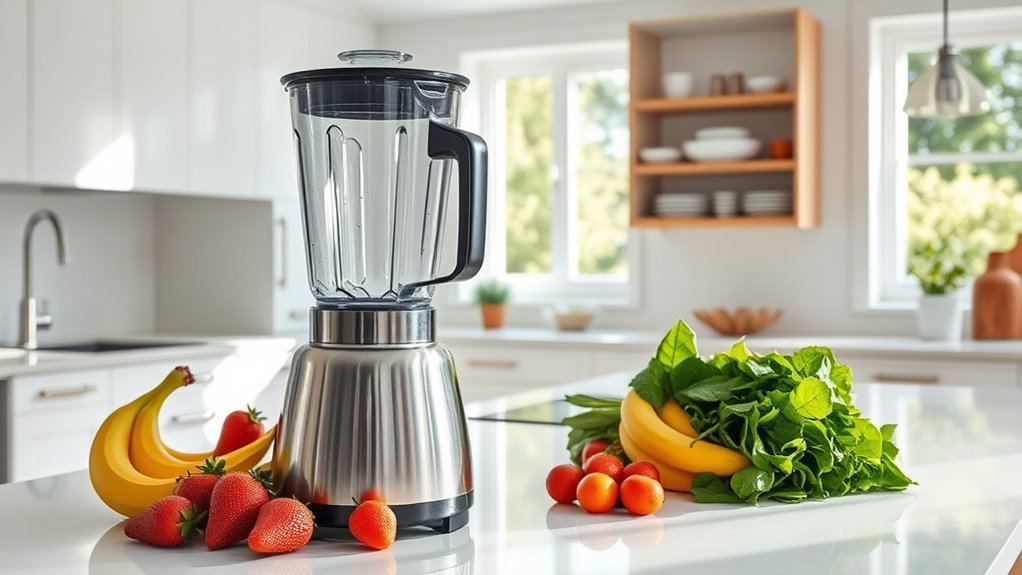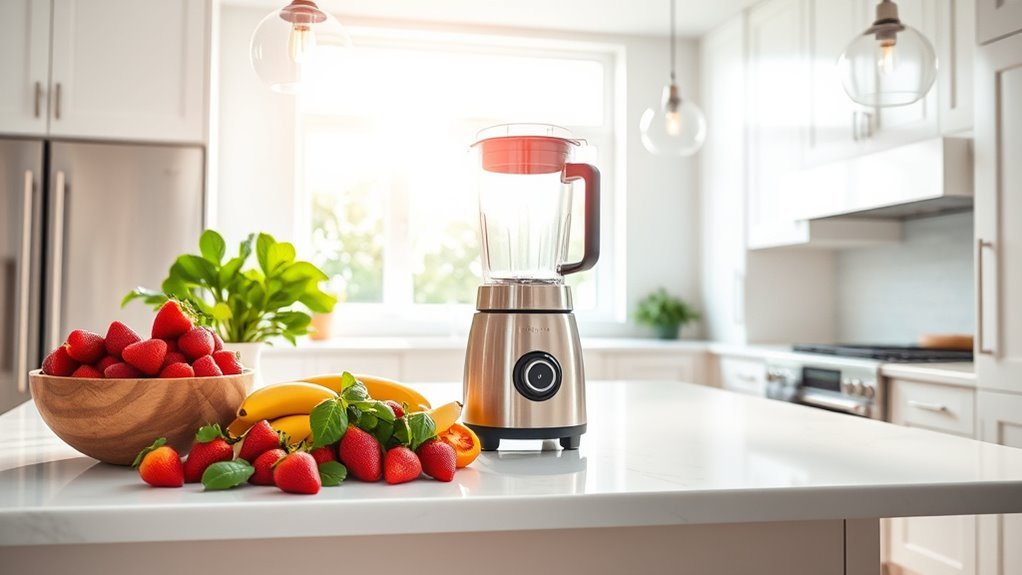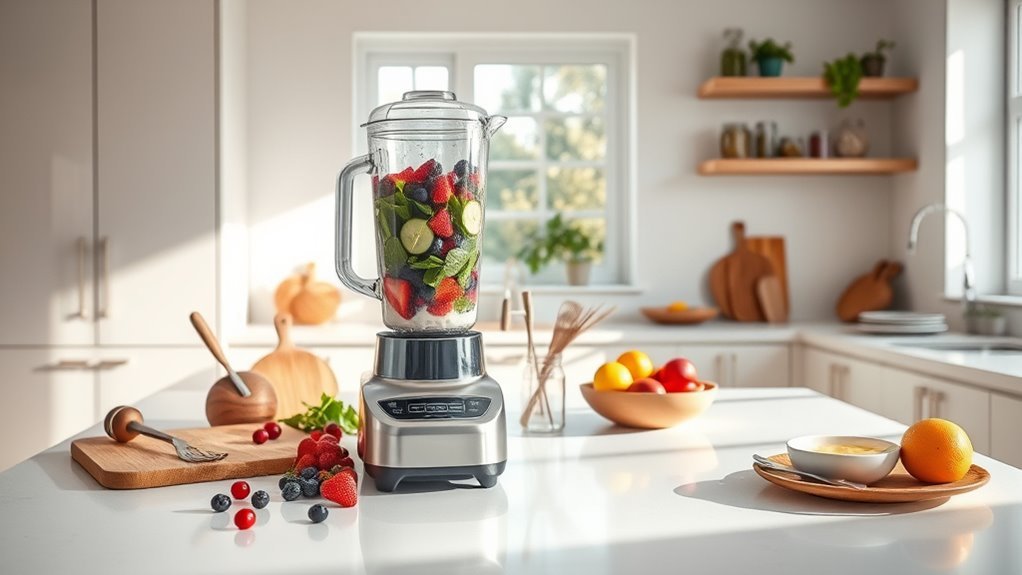Did you know that kitchen cleanup consumes an average of 42 minutes daily for most home cooks? When it comes to blenders, the cleaning battle between immersion and countertop models isn’t even close. We’ve tested both extensively in our kitchen lab, and the difference in cleanup time is striking. The immersion blender’s simple design means fewer parts to wash, while those countertop models hide residue in gaskets and crevices you didn’t even know existed. So which one deserves counter space in your kitchen?
Anatomy of Cleaning: Basic Components to Clean

When it comes to cleaning your blender, what exactly are we dealing with?
For immersion blenders, we’re looking at a pretty simple setup: a handle with a detachable blending shaft that you can rinse directly under water.
Most models also come with attachments like a whisk or food chopper that pop off for easy cleaning.
Countertop blenders, on the other hand, have more parts to tackle.
You’ll need to clean the pitcher, blades, and sometimes a removable vent cap from the lid.
The motor base should never be submerged—just wipe it with a damp cloth.
I think the biggest difference is that immersion blender parts are smaller and designed for quick rinsing, while the pitcher of a countertop model can be, well, a bit more awkward to clean thoroughly, especially around those sharp blades.
Additionally, in high-performance countertop blenders, the sharp blades often require more careful cleaning to ensure they remain effective for tough ingredients.
Speed Factor: Time Required for Complete Cleaning
Now that we understand what parts need cleaning, let’s talk about something we all care about—time.
The difference here is pretty dramatic.
Your immersion blender comes apart quickly, with compact pieces that typically take less than a minute to clean under running water.
Countertop blenders, however, demand 2-5 minutes of your time, with that bulky blending pitcher taking up space in your sink while you disassemble and scrub multiple components.
What makes immersion blenders ideal for busy cooks is how they feature a removable wand that’s cleaned in seconds versus countertop stand blenders with their pitcher taking up space and requiring individual attention for each part.
We’ve found that time for one simple rinse is often all you need—who doesn’t appreciate that efficiency?
For high-performance blenders, proper care like regular cleaning can help them last over a decade with minimal issues.
Technique Comparison: Cleaning Methods for Each Blender

While both blender types can be cleaned effectively, the techniques we use for each differ greatly in practice.
Immersion blenders offer a more straightforward approach—we simply detach the blending wand and rinse it under running water.
Countertop blenders, on the other hand, require us to disassemble the blending jars from the base.
Here’s what we typically do with each:
- Immersion blenders – Detach attachments like whisks or food chopper attachments, rinse under water, occasionally immerse the blending wand in soapy water for deeper cleaning
- Stand blenders – Remove the jar from the base, disassemble parts if possible, wash separately (many are dishwasher-safe)
- Both types – Wipe down the motor housing with a damp cloth, never submerge in water
I’ve found immersion versus countertop stand cleaning is like comparing washing a knife to washing a food processor—one’s just inherently simpler!
Stubborn Residue Challenge: Handling Difficult Ingredients
Beyond the basic cleaning methods we’ve discussed, certain ingredients present a unique challenge for both blender types. When you crush ice or blend sticky substances, residue can be a real headache! We’ve found immersion blenders typically handle stubborn ingredients better cleaning-wise because you can detach the shaft and rinse directly under water.
| Ingredient Type | Immersion Blenders | Countertop/Stand Blenders |
|---|---|---|
| Frozen Fruits | Easy direct rinse | Requires soaking |
| Crushed Ice | Quick shaft detachment | Residue traps in blades |
| Sticky Substances | Simple wipe-down | Multiple parts to clean |
The Kenmore immersion blender with its 400W motor and detachable parts makes cleanup after tougher ingredients like ice much simpler than the 64oz Kenmore stand blenders, which, despite their power, trap residue in hard-to-reach areas.
Storage Considerations: Cleanliness and Kitchen Organization

Where you store your blender actually impacts how clean your kitchen stays—something we don’t often consider!
Immersion blenders win this round hands-down in smaller kitchen or limited counter spaces.
Kenmore’s stainless steel model breaks down into pieces that will fit neatly in drawers, making daily cleaning so much easier.
- Immersion blenders can be disassembled and tucked away, preventing dust build-up and keeping your kitchen surfaces clutter-free
- Countertop blenders with their 64-ounce blending jars require dedicated space, which, honestly, can sometimes lead to overlooked cleaning areas
- Limited counter real estate? The slim profile of an immersion blender won’t demand the permanent footprint that those bulkier models do—meaning you’ll probably clean around them more frequently
Commercial Kitchen Efficiency: Which Blender Saves More Time
How does your choice of blender impact the fast-paced environment of professional food service?
Well, it’s actually a bigger deal than most realize.
Immersion blenders shine when preparing large batches, handling up to 42 gallons with a 21-inch shaft.
They’re incredible for efficiency since you’re blending directly in pots—no transferring needed!
This means you can move quickly between stations, from salad prep to sauce-making in seconds.
Countertop blenders offer different advantages through hands-free operation and programmed functions.
Their automatic Ice Crush modes let staff multitask while big batches blend.
Plus, built-in safety features prevent overheating during busy periods.
For commercial kitchens, we’ve found both have their place, but immersion models generally offer more flexibility when time is your most precious ingredient.
Frequently Asked Questions
What Are the Disadvantages of Immersion Blenders?
We’ve found immersion blenders have power limitations, splatter issues, and stability problems. They’re prone to motor strain, heat buildup, blade wear, and safety hazards. Noise levels, durability concerns, and cost implications also exist.
Are Immersion Blenders Better Than Regular Blenders?
Like David facing Goliath, we’ve found immersion blenders excel in Versatility Options and Size Portability, while countertop models win for Blending Power and Speed Performance. They’re complementary tools serving different kitchen needs.
Are Immersion Blenders Hard to Clean?
No, immersion blenders are quite easy to clean. We’ve found their detachable parts and quick rinse speed make washing a breeze. Proper blade care and simple soap methods maintain hygiene between uses.
Do I Need an Immersion Blender if I Have a Blender?
Bulky countertops vs. sleek immersion tools—we’d say it depends. For task comparison, you don’t need both if budget’s tight, but immersion blenders excel at direct pot blending and space efficiency in daily integration.

